Influence of Structure and Texture Feature on Retrieval of Ramie Leaf Area Index
Abstract
1. Introduction
2. Materials and Methods
2.1. Study Area
2.2. Data Acquisition and Processing
2.2.1. Ground LAI Acquisition
2.2.2. UAV Multispectral Data Acquisition and Processing
2.3. Model Construction and Evaluation
3. Results
3.1. Effect of Canopy Coverage on Ramie LAI Inversion
3.1.1. Difference Analysis of LAI in Different Canopy Coverage Datasets
3.1.2. LAI Inversion Performance in Different Canopy Coverage Dataset
3.2. Effect of Plant Height on Ramie LAI Inversion
3.2.1. Difference Analysis of LAI in Different Plant Height Datasets
3.2.2. LAI Inversion Performance in Different Plant Height Dataset
3.3. Effect of Texture Feature on Ramie LAI Inversion
3.4. Multi-Feature Fusion to Improve LAI Estimation Accuracy
4. Discussion
4.1. Effect of Structural and Texture Features on Crop LAI Inversion
4.2. Multi-Feature Fusion Can Improve LAI Estimation Accuracy
4.3. Machine Learning Technology Can Improve the Accuracy of LAI Estimation
5. Conclusions
Author Contributions
Funding
Institutional Review Board Statement
Informed Consent Statement
Data Availability Statement
Acknowledgments
Conflicts of Interest
References
- Li, Z.H. Research on the Development of Ramie Industry in China (1860–1958). Doctoral Thesis, Central China Normal University, Wuhan, China, 2013. [Google Scholar]
- Li, H.J.; Bai, Y.L.; Wang, F. Research progress of bioactive constituents of ramie leaves and their application. Biochemistry 2022, 8, 180–182. [Google Scholar]
- Su, X.H.; She, W.; Yang, R.F. Cloning and expression analysis of heavy metal ATPase BnHMA1 gene in ramie. Plant Physiol. J. 2020, 56, 1531–1540. [Google Scholar]
- Gao, G.; Xiong, H.P.; Chen, P. Effects of feeding ramie tender stem and leaf silage on fattening effect and muscle quality of Goats. Feed. Ind. 2016, 37, 20–23. [Google Scholar]
- Xue, X.X.; Lu, J.W.; Li, X.K. Effects of potassium deficiency on nutrition and physiological characters of rice leaves under different nitrogen application rates. J. Plant Nutr. Fertil. 2016, 22, 1494. [Google Scholar]
- Liu, K.; Zhou, Q.; Wu, W.; Chen, Z.; Tang, H. Comparison between multispectral and hyperspectral remote sensing for LAI estimation. Trans. CSAE 2016, 32, 155–162. [Google Scholar]
- Alexandridis, T.K.; Ovakoglou, G.; Clevers, J.G. Relationship between MODIS EVI and LAI across time and space. Geocarto Int. 2020, 35, 1385–1399. [Google Scholar] [CrossRef]
- Zhang, H.M.; Liu, W.; Han, W.T.; Liu, Q.Z.; Song, R.J.; Hou, G.H. Inversion of summer maize leaf area index based on gradient boosting decision tree algorithm. Trans. Chin. Soc. Agric. Mach. 2019, 50, 258–266. [Google Scholar]
- Olivas, P.C.; Oberbauer, S.F.; Clark, D.B.; Clark, D.A.; Ryan, M.G.; O’Brien, J.J.; Ordoñez, H. Comparison of direct and indirect methods for assessing leaf area index across a tropical rain forest landscape. Agric. For. Meteorol. 2013, 177, 110–116. [Google Scholar] [CrossRef]
- Castro-Valdecantos, P.; Apolo-Apolo, O.E.; Pérez-Ruiz, M.; Egea, G. Leaf area index estimations by deep learning models using RGB images and data fusion in maize. Precis. Agric. 2022, 23, 1949–1966. [Google Scholar] [CrossRef]
- Zhu, W.; Sun, Z.; Huang, Y.; Lai, J.; Li, J.; Zhang, J.; Yang, B.; Li, B.; Li, S.; Zhu, K.; et al. Improving field-scale wheat LAI retrieval based on UAV remote sensing observations and optimized VI-LUTs. Remote Sens. 2019, 11, 2456. [Google Scholar] [CrossRef]
- Wang, J.; Jiang, Y. Inversion of soybean leaf area index based on UAV multispectral remote sensing. Chin. Agric. Sci. Bull. 2021, 37, 134–142. [Google Scholar]
- Shao, P.P. Estimation of Rice Leaf Area Index by Hyperspectral and Multispectral Remote Sensing; Wuhan University: Wuhan, China, 2019. [Google Scholar]
- Zhou, X.; Zheng, H.B.; Xu, X.Q.; He, J.Y.; Ge, X.K.; Yao, X.; Cheng, T.; Zhu, Y.; Cao, W.X.; Tian, Y.C. Predicting grain yield in rice using multi-temporal vegetation indices from UAV-based multispectral and digital imagery. ISPRS J. Photogramm. Remote Sens. 2017, 130, 246–255. [Google Scholar] [CrossRef]
- Zhang, J.; Wang, C.; Yang, C.; Xie, T.; Jiang, Z.; Hu, T.; Luo, Z.; Zhou, G.; Xie, J. Assessing the Effect of Real Spatial Resolution of In Situ UAV Multispectral Images on Seedling Rapeseed Growth Monitoring. Remote Sens. 2020, 12, 1207. [Google Scholar] [CrossRef]
- Campos-Taberner, M.; García-Haro, F.J.; Camps-Valls, G.; Grau-Muedra, G.; Nutini, F.; Crema, A.; Boschetti, M. Multitemporal and multiresolution leaf area index retrieval for operational local rice crop monitoring. Remote Sens. Environ. 2016, 187, 102–118. [Google Scholar] [CrossRef]
- Liang, D.; Guan, Q.; Huang, W.; Huang, L.; Yang, G. Remote sensing inversion of leaf area index based on support vector machine regression in winter wheat. Trans. Chin. Soc. Agric. Eng. 2013, 29, 117–123. [Google Scholar]
- Liang, L.; Huang, T.; Di, L.; Geng, D.; Yan, J.; Wang, S.; Wang, L.; Li, L.; Chen, B.; Kang, J. Influence of different bandwidths on LAI estimation using vegetation indices. IEEE J. Sel. Top. Appl. Earth Obs. Remote Sens. 2020, 13, 101. [Google Scholar] [CrossRef]
- Shao, G.M.; Wang, Y.J.; Han, W.T. Estimation method of leaf area index for summer maize using UAV-based on multispectral remote sensing. Smart Agric. 2020, 2, 118–128. [Google Scholar]
- Sun, S.R.; Zhao, Y.L.; Wang, Y.J. Leaf area index inversion of winter wheat based on UAV multi-spectral remote sensing. J. China Agric. Univ. 2019, 24, 51–58. (In Chinese) [Google Scholar]
- Jacquemoud, S.; Baret, F. PROSPECT–a model of leaf ptical-properties spectra. Remote Sens. Environ. 1990, 34, 75–91. [Google Scholar] [CrossRef]
- Mananze, S.; Pôças, I.; Cunha, M. Retrieval of Maize Leaf Area Index Using Hyperspectral and Multispectral Data. Remote Sens. 2018, 10, 1942. [Google Scholar] [CrossRef]
- Alabi, T.R.; Abebe, A.T.; Chigeza, G.; Fowobaje, K.R. Estimation of soybean grain yield from multispectral high-resolution UAV data with machine learning models in West Africa. Remote Sens. Appl. Soc. Environ. 2022, 27, 100782. [Google Scholar] [CrossRef]
- Narmilan, A.; Gonzalez, F.; Salgadoe, A.S.A.; Kumarasiri, U.W.L.M.; Weerasinghe, H.A.S.; Kulasekara, B.R. Predicting canopy chlorophyll content in sugarcane crops using machine learning algorithms and spectral vegetation indices derived from UAV multispectral imagery. Remote Sens. 2022, 14, 1140. [Google Scholar] [CrossRef]
- Liu, C.; Yang, G.; Li, Z.; Tang, F.; Wang, J.; Zhang, C.; Zhang, L. Biomass estimation in winter wheat by UAV spectral information and texture information fusion. Sci. Agric. Sinica. 2018, 51, 3060–3073. [Google Scholar]
- Gao, M.Y.; Zhang, J.S.; Pan, Y.Z. Inversion of leaf area index of winter wheat based on vegetation index and crop height. Chin. J. Agric. Resour. Reg. Plan. 2020, 41, 49–57. [Google Scholar]
- Niu, Y.J.; Li, X.P.; Zhang, J.B. Inversion of leaf area index in winter wheat by merging UAV Lidar with multispectral remote sensing data. Acta Pedol. Sinica. 2022, 59, 161–171. [Google Scholar]
- Cai, W.J.; Sha, J.M. Quantitative inversion of leaf area index by remote sensing based on geographical environment factors. J. Subtrop. Resour. Environ. 2019, 14, 55–64. [Google Scholar]
- Hang, Y.H.; Su, H.; Yu, Z.Y. Estimation of rice leaf area index combining UAV spectrum, texture features and vegetation coverage. Trans. Chin. Soc. Agric. Eng. 2021, 37, 64–71. [Google Scholar]
- Tao, H.; Xu, L.; Feng, H.; Yang, G.; Dai, Y.; Niu, Y. Estimation of plant height and leaf area index of winter wheat based on UAV hyperspectral Remote sensing. Trans. Chin. Soc. Agric. Mach. 2020, 51, 193–201. [Google Scholar]
- Sun, B.; Wang, C.; Yang, C.; Xu, B.; Zhou, G.; Li, X.; Xie, J.; Xu, S.; Liu, B.; Xie, T.; et al. Retrieval of rapeseed leaf area index using the PROSAIL model with canopy coverage derived from UAV images as a correction parameter. Int. J. Appl. Earth Obs. Geoinf. 2021, 102, 102373. [Google Scholar] [CrossRef]
- Yang, K.; Gong, Y.; Fang, S.; Duan, B.; Yuan, N.; Peng, Y.; Wu, X.; Zhu, R. Combining Spectral and Texture Features of UAV Images for the Remote Estimation of Rice LAI throughout the Entire Growing Season. Remote Sens. 2021, 13, 3001. [Google Scholar] [CrossRef]
- Qiao, K.; Zhu, W.; Xie, Z.; Li, P. Estimating the seasonal dynamics of the leaf area index using piecewise LAI-VI relationships based on phenophases. Remote Sens. 2019, 11, 689. [Google Scholar] [CrossRef]
- Sakamoto, T.; Shibayama, M.; Kimura, A.; Takada, E. Assessment of digital camera-derived vegetation indices in quantitative monitoring of seasonal rice growth. ISPRS J. Photogramm. Remote Sens. 2011, 66, 872–882. [Google Scholar] [CrossRef]
- Li, S.; Yuan, F.; Ata-UI-Karim, S.T.; Zheng, H.; Cheng, T.; Liu, X.; Tian, Y.; Zhu, Y.; Cao, W.; Cao, Q. Combining color indices and textures of UAV-based digital imagery for rice lai estimation. Remote Sens. 2019, 11, 1793. [Google Scholar] [CrossRef]
- Yang, F.Q.; Feng, H.K.; Xiao, T.H. Estimation of nitrogen nutrition index of winter wheat by combining UAV image spectral and texture features. Res. Agric. Mod. 2020, 41, 718–726, (In Chinese with English Abstract). [Google Scholar]
- Chen, P.; Feng, H.K.; Li, C.C. UAV image spectrum and texture fusion information to estimate potato leaf chlorophyll content. Trans. Chin. Soc. Agric. Eng. (Trans. CSAE) 2019, 35, 63–74, (In Chinese with English Abstract). [Google Scholar]
- Huete, A.R.; Jackson, R.D.; Post, D.F. Spectral response of a plant canopy with different soil backgrounds. Remote Sens. Environ. 1985, 17, 37–53. [Google Scholar] [CrossRef]
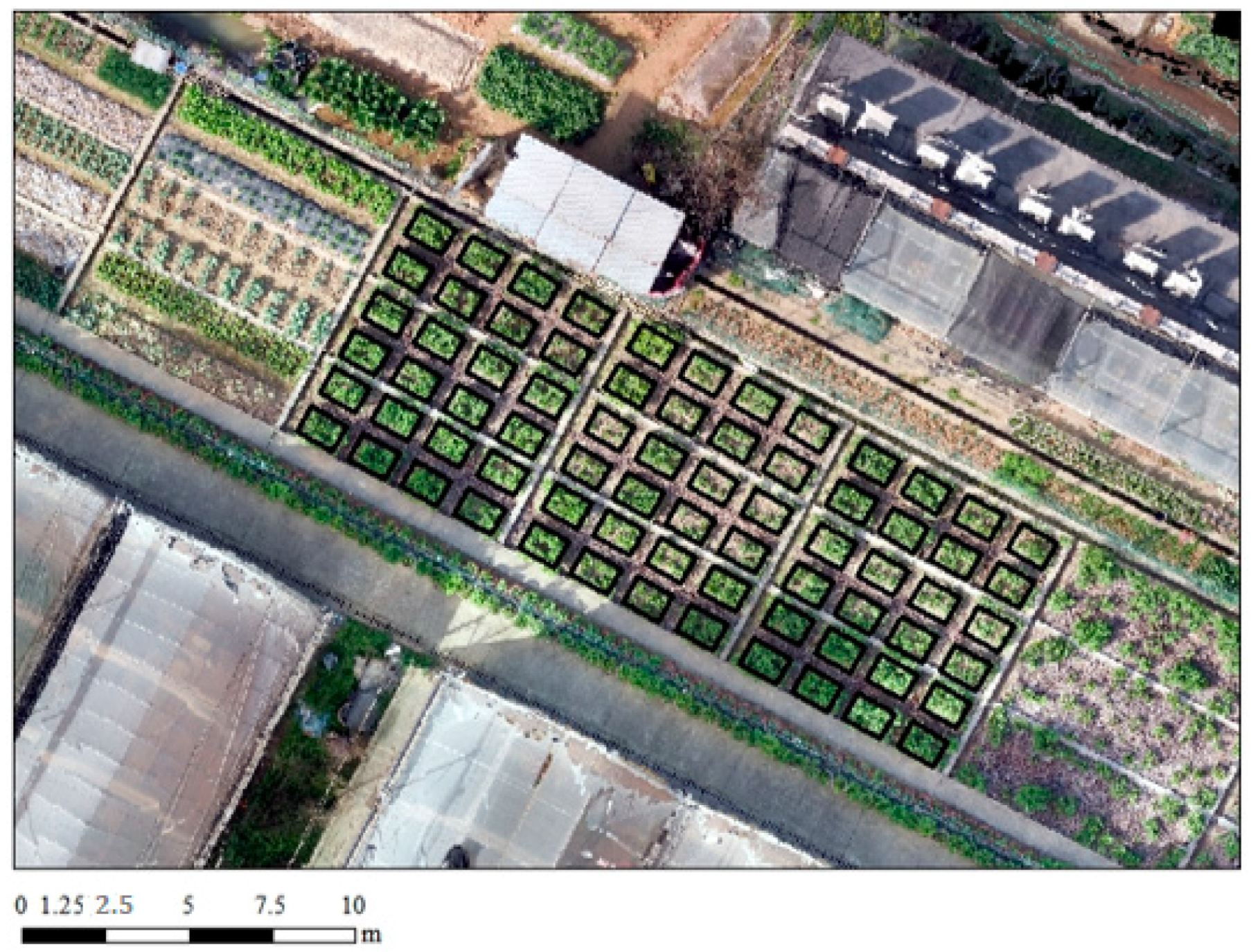
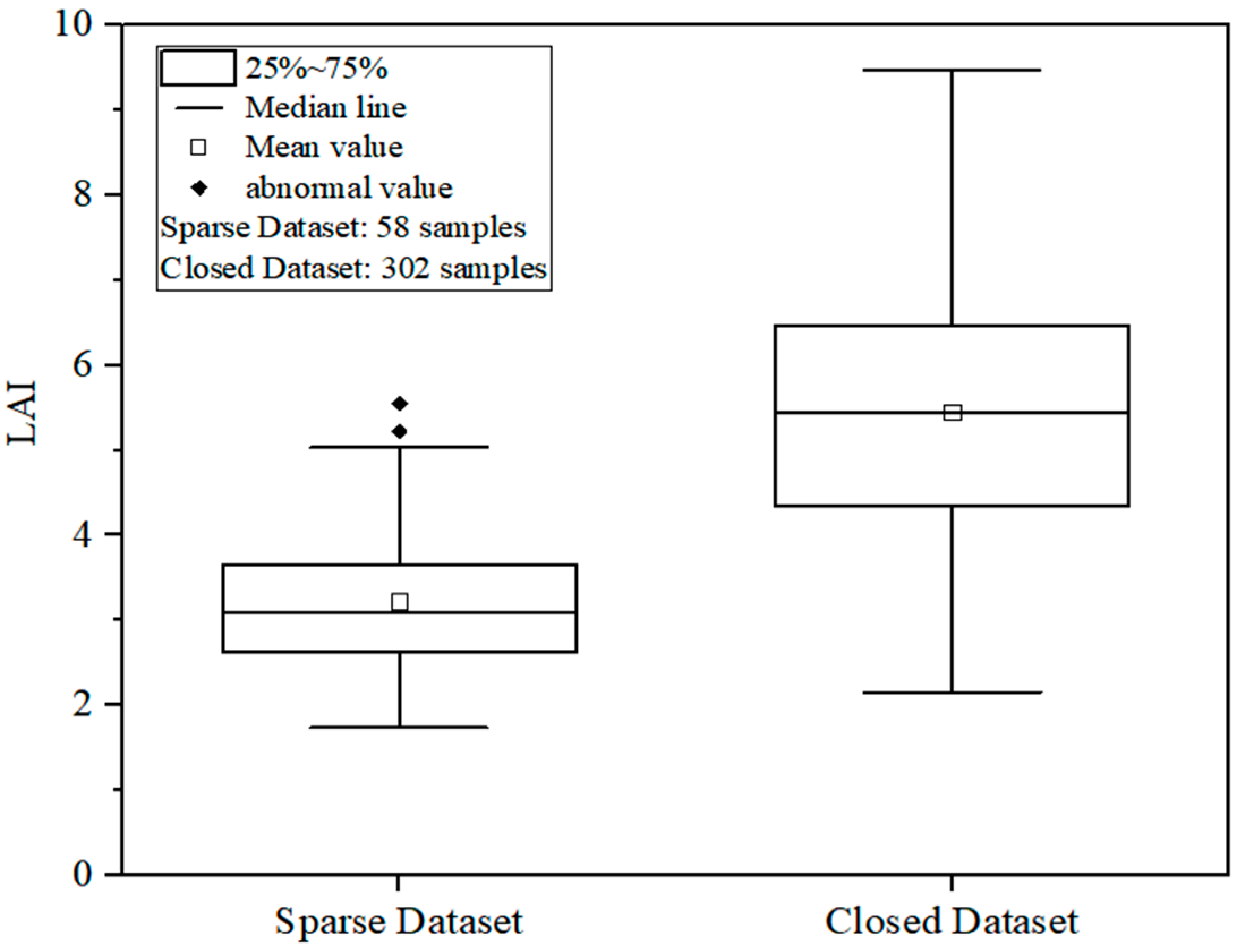



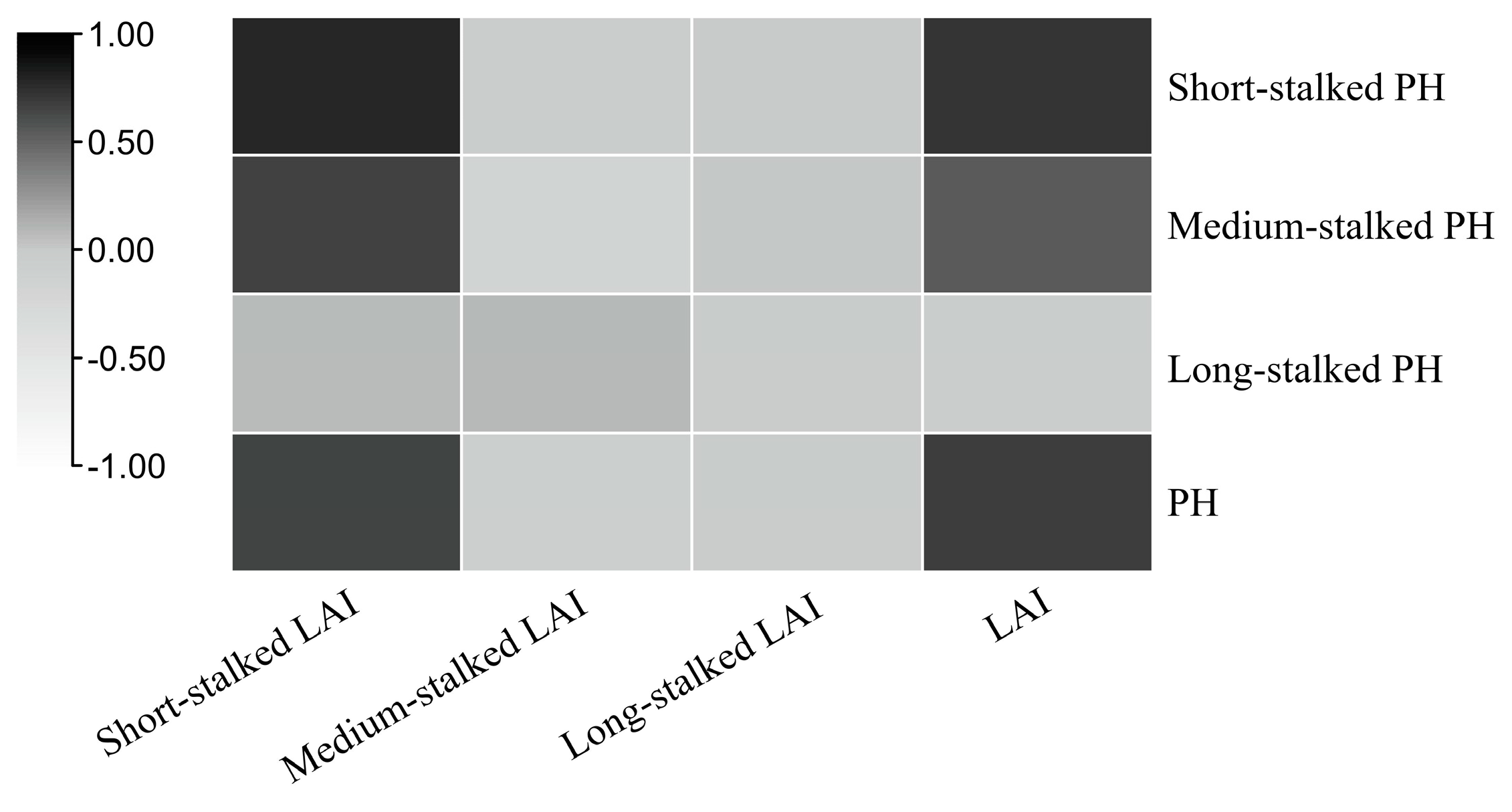
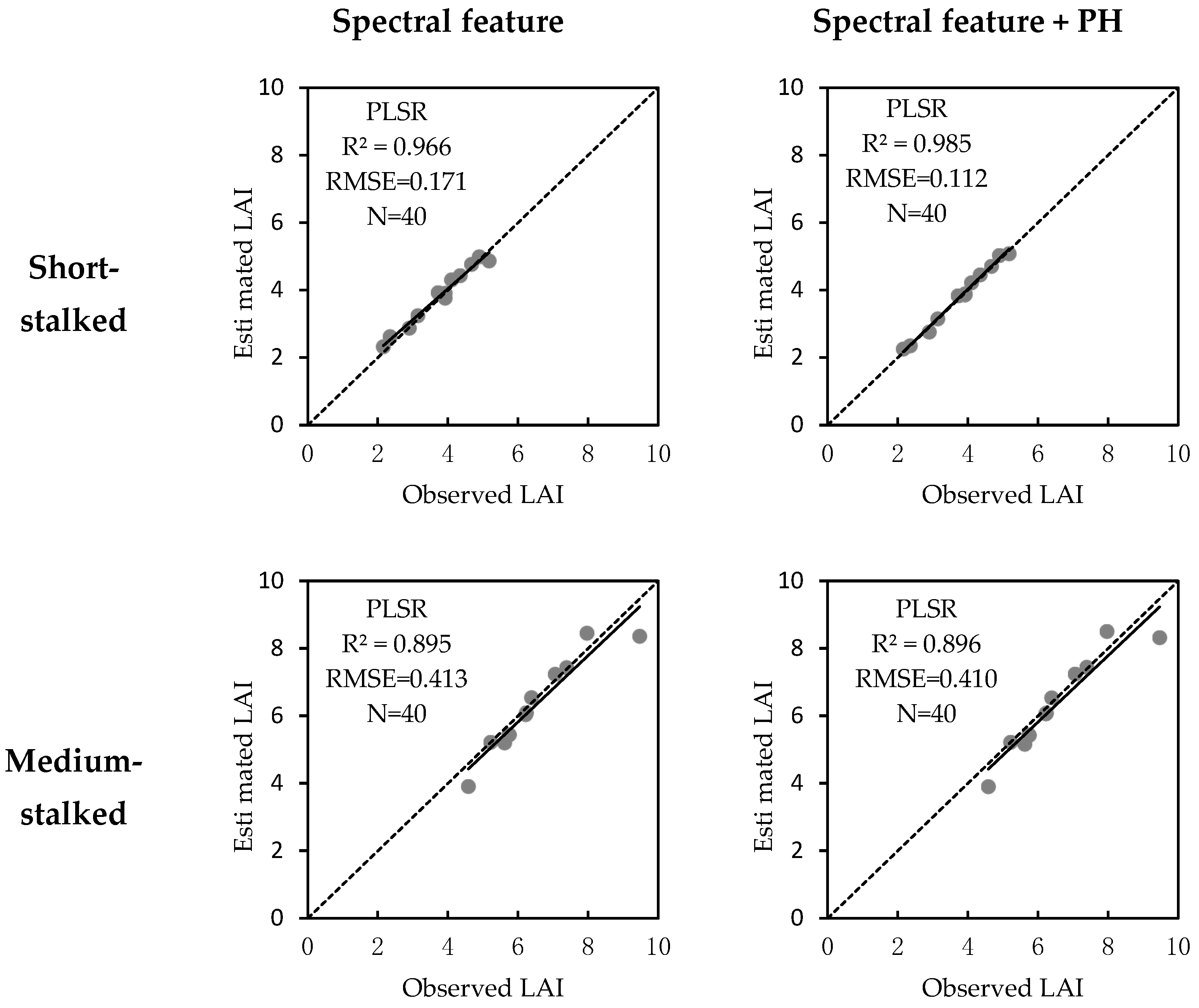
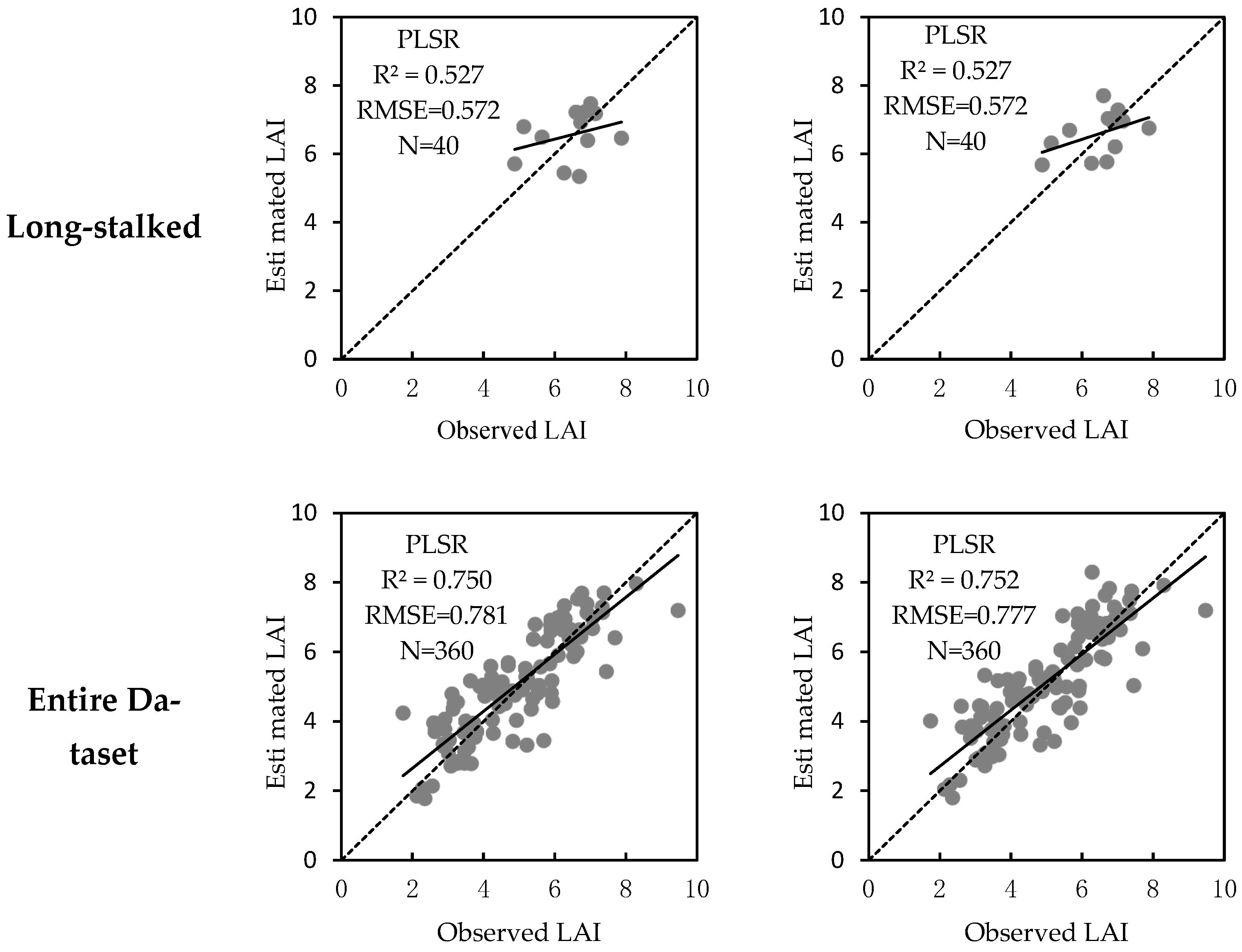
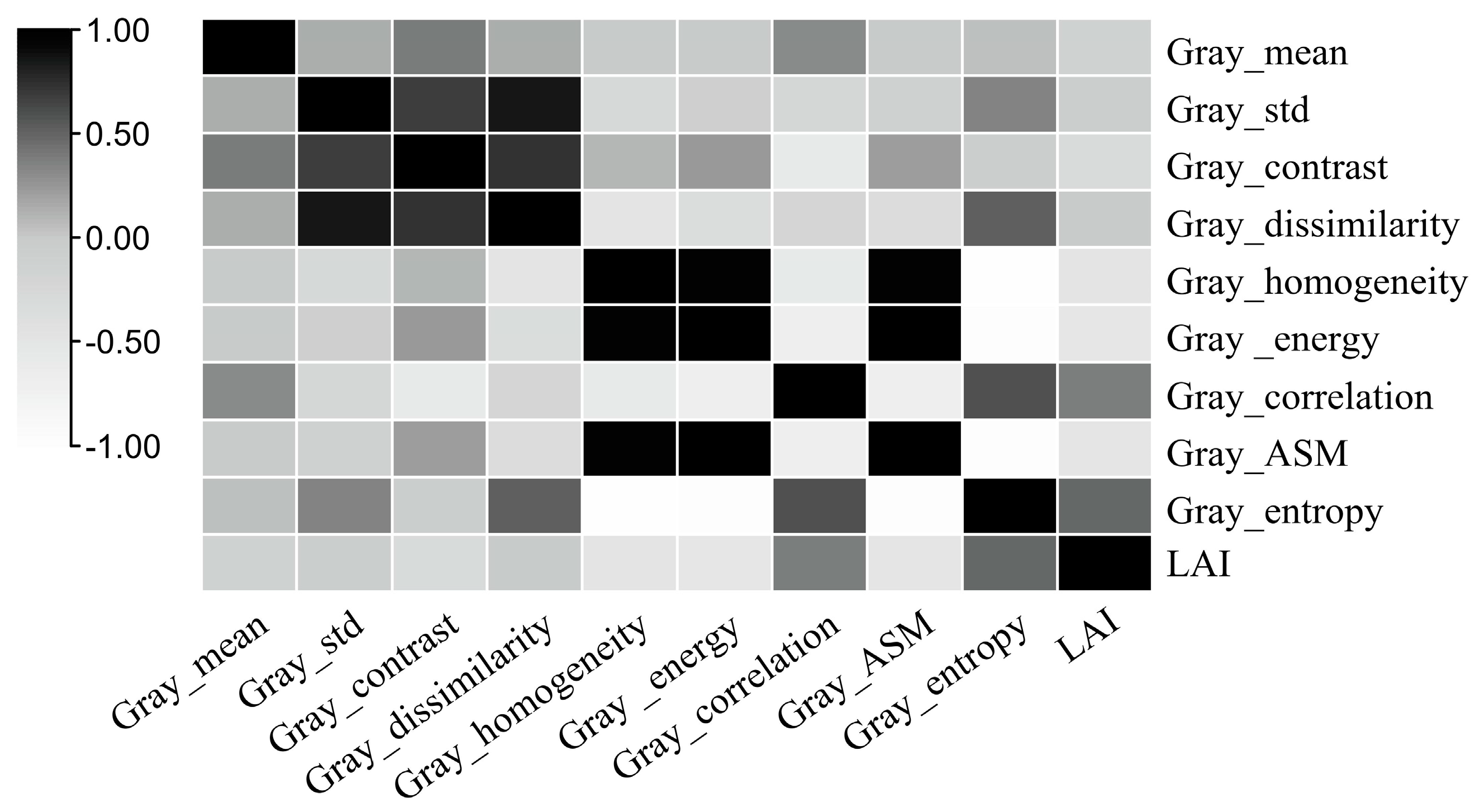

| Dataset | CC Range | Number | Min | Max | Mean | Std | CV (%) |
|---|---|---|---|---|---|---|---|
| Sparse Dataset | 0.294–0.898 | 58 | 1.734 | 5.548 | 3.227 | 0.826 | 0.682 |
| Closed Dataset | 0.900–1 | 58 | 2.155 | 6.451 | 4.786 | 0.967 | 0.935 |
| Entire Dataset | 0.294–1 | 360 | 1.734 | 9.467 | 5.090 | 1.497 | 2.241 |
| Dataset | PH Range | Number | Min | Max | Mean | Std | CV (%) |
|---|---|---|---|---|---|---|---|
| Short-stalked | 14.500–78.125 | 40 | 1.983 | 6.451 | 3.992 | 1.0383 | 1.078 |
| Medium-stalked | 100–199.800 | 40 | 3.840 | 9.470 | 5.782 | 1.246 | 1.553 |
| Long-stalked | 200–232 | 40 | 3.900 | 7.880 | 6.312 | 0.809 | 0.655 |
| Entire Dataset | 14.330–232 | 360 | 1.730 | 9.470 | 5.089 | 1.497 | 2.241 |
| Model | Spectral Feature | Multi-Feature | ||
|---|---|---|---|---|
| R2 | RMSE | R2 | RMSE | |
| LR | 0.706 | 0.847 | 0.562 | 1.034 |
| RF | 0.760 | 0.765 | 0.760 | 0.765 |
| PLSR | 0.750 | 0.781 | 0.759 | 0.766 |
| SVR | 0.759 | 0.766 | 0.776 | 0.740 |
Disclaimer/Publisher’s Note: The statements, opinions and data contained in all publications are solely those of the individual author(s) and contributor(s) and not of MDPI and/or the editor(s). MDPI and/or the editor(s) disclaim responsibility for any injury to people or property resulting from any ideas, methods, instructions or products referred to in the content. |
© 2023 by the authors. Licensee MDPI, Basel, Switzerland. This article is an open access article distributed under the terms and conditions of the Creative Commons Attribution (CC BY) license (https://creativecommons.org/licenses/by/4.0/).
Share and Cite
Fu, H.; Lu, J.; Chen, J.; Wang, W.; Cui, G.; She, W. Influence of Structure and Texture Feature on Retrieval of Ramie Leaf Area Index. Agronomy 2023, 13, 1690. https://doi.org/10.3390/agronomy13071690
Fu H, Lu J, Chen J, Wang W, Cui G, She W. Influence of Structure and Texture Feature on Retrieval of Ramie Leaf Area Index. Agronomy. 2023; 13(7):1690. https://doi.org/10.3390/agronomy13071690
Chicago/Turabian StyleFu, Hongyu, Jianning Lu, Jianfu Chen, Wei Wang, Guoxian Cui, and Wei She. 2023. "Influence of Structure and Texture Feature on Retrieval of Ramie Leaf Area Index" Agronomy 13, no. 7: 1690. https://doi.org/10.3390/agronomy13071690
APA StyleFu, H., Lu, J., Chen, J., Wang, W., Cui, G., & She, W. (2023). Influence of Structure and Texture Feature on Retrieval of Ramie Leaf Area Index. Agronomy, 13(7), 1690. https://doi.org/10.3390/agronomy13071690





